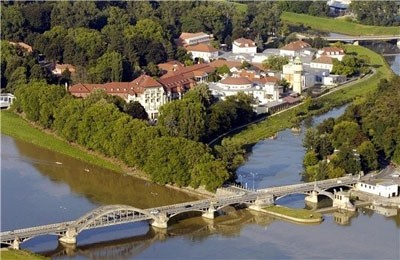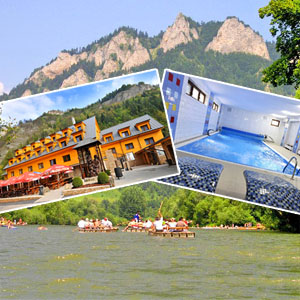Piešťany
 Piešťany (German: Pistyan; Hungarian: Pöstyén, Polish: Pieszczany) is a town in Slovakia. It is located in the western part of the country within the Trnava Region and is the seat of its own district. It is the biggest and best known spa town in Slovakia and has around 30,000 inhabitants.
Piešťany (German: Pistyan; Hungarian: Pöstyén, Polish: Pieszczany) is a town in Slovakia. It is located in the western part of the country within the Trnava Region and is the seat of its own district. It is the biggest and best known spa town in Slovakia and has around 30,000 inhabitants.
History
The first human settlement in the area is dated to the prehistoric times, about 80,000 years ago. People were attracted to the site by abundance of game in the vicinity of the thermal springs that did not freeze in winter.
A small female statue called Venus of Moravany was found in the nearby village Moravany nad Váhom. It is made of mammoth ivory and is dated to 22,800 BC. It currently resides in the Bratislava Castle museum. In another nearby village, Krakovany-Stráže, a treasure consisting of luxury items made of glass, bronze, silver, and gold was discovered in three graves from 200 - 300 AD. The surroundings of Piešťany also include the Great Moravian castle of Ducové.
Piešťany was first mentioned in written records in 1113 (under the name Pescan). At that time it consisted of several smaller settlements. The medicinal springs were already popular in the Middle Ages. They were visited by the Hungarian king Matthias Corvinus. The first book mentioning the Piešťany springs was De admirandis Hungariae aquis hypomnemation (About the Miraculous Waters of the Hungarian Monarchy) by Georgius Wernher, published in 1549 in Basel. In the 16th century, the Piešťany spa was also mentioned by two prominent physicians, Johann Crato de Crafheim (who served to several Holy Roman Emperors) and Andrea Baccius Elpidianus (a personal surgeon of the Pope). The first monography (Schediasma de Thermis Postheinsibus by Ján Justus Torkoš) was published in 1745. But in the 16th and 17th centuries, Piešťany also suffered from Turkish raids and anti-Habsburg uprisings.
Throughout the centuries Piešťany was owned by several noble families; the last of them, the Erdődys, owned the area from 1720 to 1848, and the spa until 1940. The Erdődy family built the first spa buildings in 1778. They were damaged by a destructive flood in 1813. In 1820 the spa buildings were expanded and remodeled in neo-classical style and named Napoleon spa. The Erdődy family also established the Spa park in this period. In the years 1889 to 1940 the Winter family rented the spa from the Erdődys and brought it to international fame. The Winters improved spa treatment as well as accommodation and entertainment for visitors. They built several spa buildings and hotels.
The spa attracted many aristocratic visitors, including Ludwig van Beethoven. In 1917, three monarchs (Wilhelm II of Germany, Karl I of Austria-Hungary, and Ferdinand I of Bulgaria) orchestrated their war strategy during the negotiations in the Thermia Palace hotel.
In 1945 Piešťany received the official status of a town. In 1959, Sĺňava water reservoir was built south of the town. In the late 1960s and 1970s more spa buildings were built. In 1973 the village of Banka, located on the left bank of the Váh river, was amalgamated with Piešťany, but it regained independence after a referendum in 1995. In 1996 the town became the seat of a district.
On January 4, 1987, at the final match in the World Junior Championships of ice hockey between Canada and the Soviet Union there was a bench-clearing brawl, now famously known as the Punch-up in Piestany. Both teams were disqualified from competition as a result.
On July 5, 2001 three members of the Real Irish Republican Army were arrested in Piešťany. They were lured into a trap by agents of the British Security Service MI5 who were posing as arms dealers from Iraq.
Geography
Piešťany is situated in the western part of Slovakia, in the valley of the Váh river, at an elevation of 162 m (531 ft). The Považský Inovec mountains form the eastern boundary of this part of the Váh valley. The highest hill of these mountains, Inovec (1,042 m or 3,419 ft), is about 25 km north of the town. The hills immediately east of the town (about 10 km away) reach a height of about 700 m (2,300 ft). On the western side, the valley boundary is formed by the Little Carpathians, which are somewhat lower and further away from the town. The valley is open to the south, and thus has a warm and sunny temperate climate.
Most of the town is located on the right bank of the river. South of the town is the Sĺňava water reservoir created by a dam on the Váh river. The artificial canal Biskupický kanál and the main river branch join in the town. Another short branch of the river (Obtokové rameno) creates the Spa Island.
The hills of Považský Inovec are mostly covered with deciduous forests. These consist of oak and hornbeam in the lower elevations, and beech in the higher elevations. The Váh valley is used for agriculture. The main products are cereals, sugar beet, animal feed, and pork.
Piešťany is located 75 km north-east of Bratislava, the capital of Slovakia, and 30 km north-east of the local regional seat Trnava. Upstream from Piešťany on the Váh river are the towns Nové Mesto nad Váhom (19 km north of Piešťany) and Trenčín (40 km north-east); 17 km downstream is Hlohovec.
Piešťany is located on the route of the D1 motorway from Bratislava to Žilina with connections to Vienna and Brno. The main railway route from Bratislava to Žilina and Košice also goes through the town. The town has an airport, mostly used for international charter flights for spa clients (10,000 passengers in 2007). The municipality operates a local public transport system with 11 bus routes (as of 2008).
Spa Piešťany
The Piešťany spa has a capacity of two thousand beds (as of 2004) and treats over forty thousand patients a year. More than 60% of the clients are foreigners (mostly from Germany, the Czech Republic, Israel, Arab countries, and Austria). The spa specializes in treatment of chronic rheumatic and arthritic diseases and post-accident lesions of joints and bones.
The spa is located on the Spa Island between two branches of the Váh river, at the site of several hot springs with temperatures of 67–69 °C. The water originates in a tectonic break at 2,000 meters depth. The sulfate-carbonate water from the springs is used in pools and tubs. Sulfurous mud extracted from the bed of a side channel of the river is also used for treatment in the form of thermal mud pools with temperature 39 °C and for partial and full body packs. Spring water and mud therapy is complemented by electrotherapy, exercise, massage, medication, and diet.
The spa is operated by the company Slovenské liečebné kúpele. The company was purchased in 2002 by Danubius Hotels Group. A small share is owned by the town. Danubius Hotels Group also owns hotels in Hungary, Mariánské Lázně spa in Czech Republic and Sovata spa in Romania.









